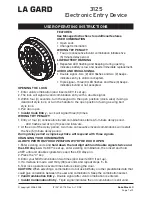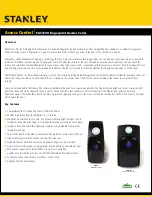
Intel® Server System R2000LH2/T2 Product Family TPS
Thermal Management
Revision 1.0
35
4.2
Thermal Management Overview
In order to maintain the necessary airflow within the system, all of the previously listed
components and top cover need to be properly installed. For best system performance, the
external ambient temperature should remain below 35ºC and all system fans should be
operational. The system is designed for fan redundancy. If a single system fan fails, integrated
platform management will change the state of the System Status LED to flashing Green, report
an error to the system event log, and automatically increase the fan speeds of all remaining
system fans in order to maintain system temperatures below maximum thermal limits.
If system thermals continue to increase with the system fans operating at their maximum speed,
platform management may begin to throttle bandwidth of either the memory subsystem or the
processors or both, in order to keep components from overheating and keep the system
operational. Throttling of these subsystems will continue until system thermals are reduced
below preprogrammed limits.
If system thermals increase to a point beyond the maximum thermal limits, the system will shut
down, the System Status LED will change to a solid Amber state, and the event will be logged to
the system event log.
Note: Sensor data records (SDRs) for any given system configuration must be loaded by the
system integrator for proper thermal management of the system. SDRs are loaded using the
FRUSDR utility.
An intelligent Fan Speed Control (FSC) and thermal management technology (mechanism) is
used to maintain comprehensive thermal protection, deliver the best system acoustics, and
improve fan power efficiency. Options in <F2> BIOS Setup (
BIOS
>
Advanced
>
System
Acoustic and Performance Configuration
) allow for parameter adjustments based on the
actual system configuration and usage. Refer to the following sections for a description of each
setting.
4.2.1
Set Throttling Mode
This option is used to select the desired memory thermal throttling mechanism. Available
settings include [Auto], [DCLTT], [SCLTT] and [SOLTT].
[Auto] – Factory Default Setting: BIOS automatically detects and identifies the
appropriate thermal throttling mechanism based on DIMM type, airflow input, and DIMM
sensor availability.
[DCLTT] – Dynamic Closed Loop Thermal Throttling: For the SOD DIMM with system
airflow input
[SCLTT] – Static Close Loop Thermal Throttling: For the SOD DIMM without system
airflow input
[SOLTT] – Static Open Loop Thermal Throttling: For the DIMMs without sensor on DIMM
(SOD)
4.2.2
Altitude
This option sets the proper altitude that the system will be used. Available settings include
[300m or less], [301m-900m], [901m-1500m], and [Above 1500m].
Summary of Contents for S4600LT2
Page 12: ......
















































